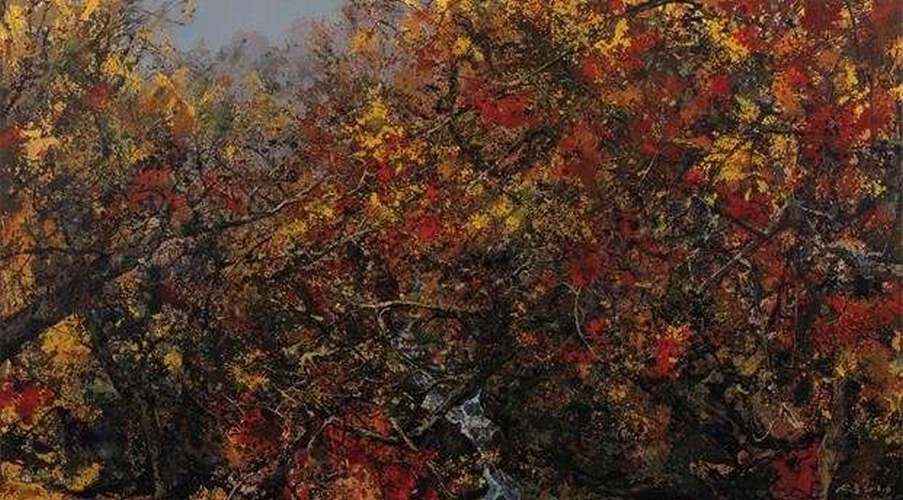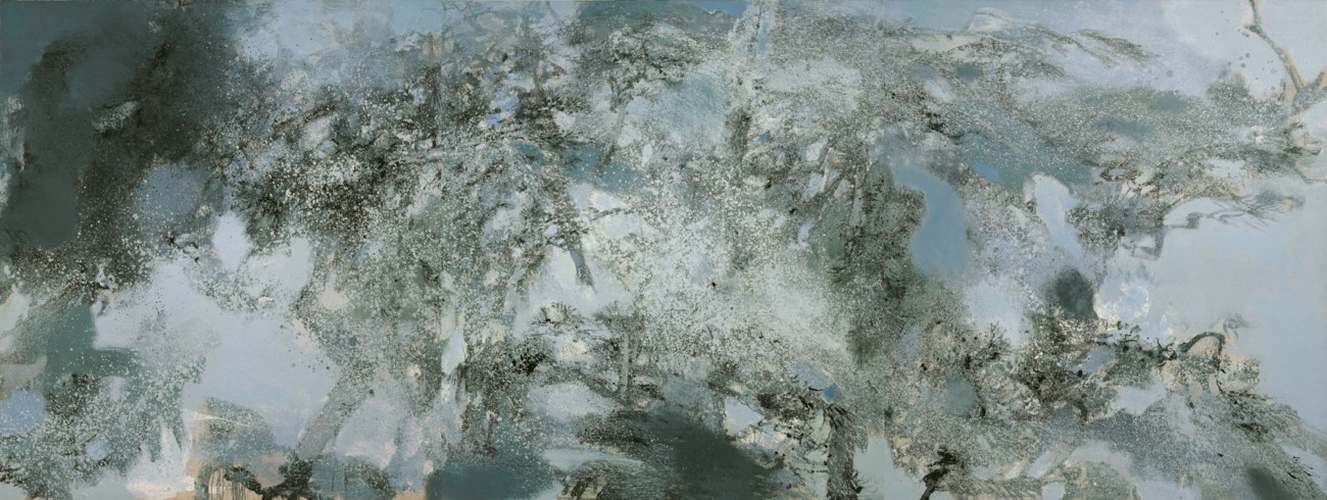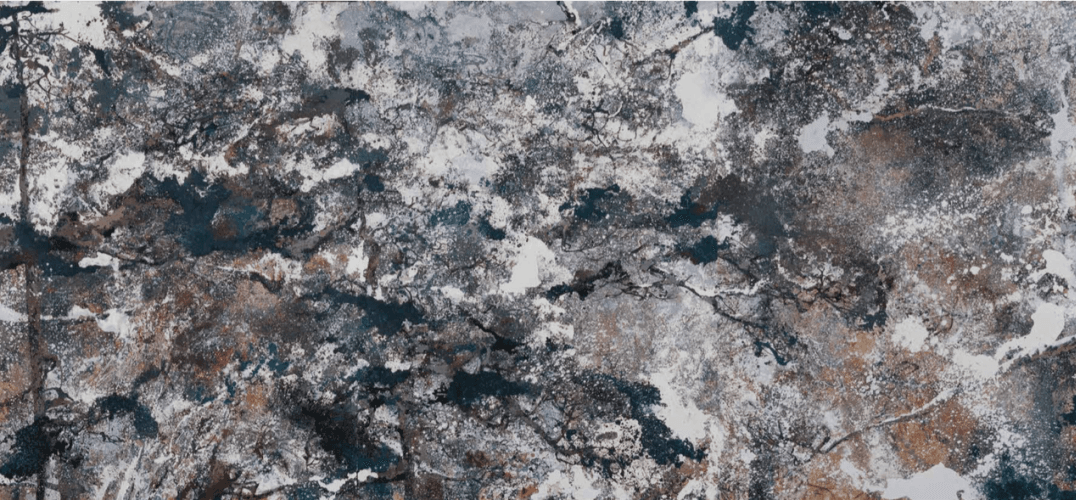Chinese 'Bone', Western 'Flesh'
Hong Ling’s biographical and artistic path shows many similarities to that of Paul Cézanne: Both were trained academically to draw and paint in the classical European manner.

Dr Ling Zhu
13 November 2017
Hong Ling’s biographical and artistic path shows many similarities to that of Paul Cézanne: Both were trained academically to draw and paint in the classical European manner.
Though the Chinese academic training Hong Ling received is borrowed from the Soviet Union, it is thus at least twice removed from its European origin. Both focussed in their early career on the rendering of the human body. Hong Ling was appointed as teacher of the Central Academy of Fine Art due to his mastering of life drawing, whereas we are all familiar with Cézanne’s studies of the bathing ladies; both then decided to devote themselves completely to landscape painting, which led them to eventually give up their life in the metropolis to become a recluse in the remote countryside, so that they could paint and learn directly from nature– Hong Ling from the Yellow Mountain, and Cézanne from the mountains of Aix, particularly from Mont Sainte-Victoire which became his perpetual obsession. Last but not least, the two artists have expressed a very similar view on the relationship between nature and art: Cezánne has famously been quoted as saying “Nature is on the inside” and “the landscape thinks itself in me, and I am its consciousness.”
Hong Ling has similarly said that to immerse oneself into nature is simultaneously to retreat into oneself. We can almost read in these statements the quintessence of what the Chinese call yi xiang shan shui 意象山水, conceptual or ideational landscape– landscape as interpreted through the mind of the artist and thus transformed from an external to an internal reality. This interpretive/transformative process however is always at the same time an engagement with the language of art, since the mind that reads nature cannot operate in a vacuum, but requires the mediation of a symbol. This article focuses on Hong Ling’s dealing with the medium of painting, on the way he developed and is in the process of perfecting a personal visual language, and on how his art positions itself in relation to both the Western and Eastern traditions. The mention of Cézanne is not random. I will come back to him later when it becomes more clear that Hong Ling’s contribution towards the art of painting can indeed be measured against that of the French artist.

I shall argue that Hong Ling’s achievement lies in having successfully combined the Chinese and European traditions of painting, not in the superficial sense of using the European medium of oil to paint a Chinese landscape, but in the more profound sense of synthesizing two aspects each essential to the tradition it belongs to. In Hong Ling’s oil paintings since the late 1990s, we can distinguish with increasing clarity two unique elements: on the one hand unstructured, uncontoured and open colour patches, on the other hand extended and clearly defined dark lines. The colour patches, which are gradated within a narrow colour spectrum, are bearers of expanding and contracting volumes, and their overlapping and clustering generate a sense of compact and impenetrable space. The dark lines on the other hand, which dynamically change their courses in a calligraphic manner, impart to the canvas a sense of unceasing movement and growth. Though often reminiscent of gnarled trees, they transcend specific representational meaning to embody and exemplify the principle of organic growth as such. The space-generating volumes are native to classical European oil painting, whereas linear dynamics is native to classical Chinese ink painting. To borrow two terms from classical Chinese art theory, Hong Ling’s paintings are organisms with Chinese ‘bone’ (gu骨) and Western ‘flesh’ (rou肉).
The above, however, remains at a mere descriptive level. To truly appreciate Hong Ling’s art, it is necessary to dig deeper into the significance of 'Chinese bone' and 'Western flesh' and to see that they represent the central principles of the two respective traditions of painting. I have referred to the lines in Hong Ling’s works as calligraphic, and Chinese painting, as has been pointed out by many, is developed from calligraphy. But what is the nature of calligraphy? What makes a line calligraphic? The answer that may immediately come to mind, namely that calligraphy is the art of the brushwork (bi fa 筆法), only repeats a cliché and does not provide a genuine answer. I argue that the essence of a calligraphic line is that it is the unfolding of the motoric impulse concentrated in its starting point. At the point where the painter sets his brush on the paper, he brings a store of energy that is to be meted out and spent, and the course of the line is the build-up, unfolding and eventual exhaustion of that initial charge of energy. To borrow two physical terms, the ‘life’ of a calligraphic line is the transformation of “potential energy” into actual “kinetic movement”. More concretely speaking, it means that the expression of a calligraphic line lies entirely in how it varies in relation to the starting point, and this with regard to a variety of factors including direction, thickness and saturation, among others.
It may sound like a mediocre observation. However, few people realize that the calligraphic thinking is almost entirely absent from classical European art. Europeans equally cultivated the art of the line to perfection. However, the European line is first and foremost a plastic line, this means it serves primarily the purpose of articulating three-dimensional volumes in a two-dimensional medium. As such it is not to be read in relation to its starting point, but in relation to the imaginary centre of the per se invisible volume, as expressing either the expansion or contraction of that volume from or towards that centre. The classical European line is therefore in the truest sense of the word a 'contour', that is, the outer boundary of an inner reality. As such it becomes incompatible with, if not even antithetical to, the calligraphic line: it is not possible for an artist to focus simultaneously on the behavior of the volume, which runs more or less perpendicular to the line, and on the behaviour of the initial motoric impulse, which runs thoroughly along the line.
Bearing this in mind, we can now return to Hong Ling’s paintings, firstly to their linear element, to what I have called the 'Chinese bone'. It has been pointed out several times that Hong Ling’s path since he first turned to landscape painting has been that towards ever more abstraction. And we can see now that this abstracting process has served to bring out the essence of the calligraphic. As the gnarled trees look less and less like trees, they become more and more pure directional forces, or “vectors” issuing from their bases. The linear vectors may depart more or less from the same pictorial plane and then thin out together into the distance to suggest a depthless thicket, as in Profusion Autumn (盤錦) painted in 2013; or they could have their departure bases located at different planes and then head in and out of the depth, as in Surge (涌) painted in 1999. These lines do not have to be continuous – they can be rhythmically interrupted for example by the colour patches, and they do not have to be drawn in the traditional Chinese brushwork manner – but can instead be produced by a combination of techniques including drop, dribble and splash, but they will always embody a dynamic force with a beginning, an end and a course in between.

We can compare Hong Ling’s paintings with works by various European artists which may in a brief glance look somewhat similar. We will see that the calligraphic is almost always missing from the lines of the latter. Not only in classical European landscapes, but also in Modernist landscapes including those by Cézanne, we can see that lines function primarily as contours (though Cézanne in his last phase came to relinquish contours) which enclose solid volumes, typically the volumes of geological formations; or, where the lines depict trees, they become solid entities themselves.
What I would especially like to mention here is the difference between Hong Ling and the Abstract Expressionists, whose works may appear particularly close to Hong Ling’s due to a variety of reasons: the same all-over pattern, the same technique of spill and splash, and the same accentuation of the kinetic-motoric quality of the line. In fact Hong Ling himself may have learnt a lot from the Abstract Expressionists. However, the lines of the Abstract Expressionists can only be characterized as gestural, which is not enough to qualify as calligraphic. The calligraphic is more than the gestural because it means controlled movement. It requires years if not decades of practice in order to produce those immensely varied inflections of the calligraphic line. Spontaneity and chance alone, as advocated by the Abstract Expressionists, cannot automatically generate that diversity of stroke-forms found in the Chinese line. In fact drawing and painting guided by pure spontaneity has a tendency towards monotony, repeating the same habitual hand movement patterns which eventually neutralize each other, as can be seen in Jackson Pollock’s Autumn Rhythm.
I would like to come now to the second major element in Hong Ling’s works, to the contourless colour patches which I have described as 'Western flesh'. I would like to elaborate here why I call them ‘Western’, since one could easily see them as manifestations of the Chinese inkwork, the Mo-fa (墨法), which in Chinese painting theories is just as important as the brushwork, the Bi-fa (筆法). It is very tempting to see Hong Ling’s works as no more than a classical Chinese landscape carried out in oil, employing both the Bi-fa and the Mo-fa. But this is not the case. There is a very subtle but essential difference between the Chinese and Western ‘flesh’ which I hope to be able to make clear here. The Chinese inkwork consists mainly in the modulation of tonal values through the gradation of the density and saturation of ink, and on the surface it may resemble the chiaroscuro in European art, which is also tonal modulation. Chiaroscuro, however, is essentially about shading, that means defining the objects’ relation towards the source of light, which in turn serves to define their three-dimensional plastic volumes. This has never been the aim of tonal modulation in classical Chinese painting. Its aim is rather – as pointed out by the British art historian Philip Rawson – to suggest different degrees of presence, which correspond with different degrees of the viewer’s visual attention, with the darkest elements occupying the centre of vision, while the paler elements gradually fade into invisibility. Interacting with the parts of paper that are left empty, the tonal differences suggest the appearing and disappearing of forms out of and into the mist, the atmosphere, or the void. We can study this principle very clearly in the masterpieces of Chinese landscapes – irrespective if they belong to the Northern or Southern school – for example in Fan Kuan’s Sitting Alone in the Mountains (臨流獨坐圖, circa 1000).

Hong Ling’s colour patches are not Chinese, because they do not indicate levels of presence, but instead have something powerfully plastic, thus European, about them. Even the white-coloured patches are not blanks in the sense of classical Chinese landscapes, but appear solid and voluminous – and it could be the solidness and voluminosity of air, mist or snow (as in for example Boundless 觀蒼莽, 2011). On the other hand, Hong Ling’s plasticity differs from that in classical European art, because it is not about defining bodies in a realistic manner, in terms of light and shade contrasts. I have mentioned earlier that Hong Ling’s lines are very different to Cézanne’s. But in terms of the deployment of colour patches, I think it is late Cézanne that Hong Ling comes closest to.
Hong Ling has said something very revealing in an interview: he thinks the Chinese way of painting on rice paper is sometimes 'too artificial' and thus 'far removed from nature', whereas Western oil painting is 'more accommodating and encompassing'– it can depict a nature that 'comes towards you'. It is exactly a landscape that comes towards the viewer, instead of one that recedes from him, that Cézanne has achieved in his late paintings, and this through a rhythmic distribution of small colour patches across the whole canvas. It is normally only about four to five major colours that he uses for his patches, and they are often disassociated from their representational meanings: the green patches my suggest trees or may not, the red patches may suggest house roofs or may not, and each of these patches have a strong plasticity due to internal tonal gradation. Through a well-paced rhythmical distribution which is strictly tied to the pictorial surface (meaning not employing foreshortening or distinguishing fore- and background), these small plastic units interweave in the eyes of the viewer into a tectonic whole that comes towards him, almost tilts towards him, including the Mont Sainte-Victoire, which in terms of realistic space is actually in the furthest background.
All these aspects mentioned can also be found in Hong Ling’s paintings: the same reduced colour palette, the same semi-abstractness, the same tonal gradation within the colour patches, the same rhythmical and planar all-over distribution, with the same effect of the landscape 'coming towards us'. When I refer to Hong Ling’s deployment of colour patches as 'Western flesh', I specifically mean its resemblance to this Cézannist principle of building a 'pictorial architecture' from small plastic building blocks. And with Cézanne, Hong Ling shares the awe for nature, the reason why I am convinced that, like the French master, he will never choose the path of complete abstraction. It is nature that he wants to capture in his paintings, and by integrating the calligraphic ‘Chinese bone’ and the plastic ‘Western flesh’, Hong Ling has managed to evoke nature’s eternal dialectic: the dialectic of change and permanence, of organic growth and tectonic presence.
All images copyright Hong Ling; courtesy Soka Art.